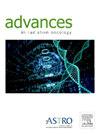Dosimetric Clues to Addressing Urinary Toxicity Following Stereotactic Prostate Radiation Therapy
IF 2.7
Q3 ONCOLOGY
引用次数: 0
Abstract
Purpose
Delayed genitourinary (GU) toxicity is reported following definitive stereotactic body radiation therapy (SBRT) for prostate cancer in 15% to 30% of patients. The purpose of this study is to investigate whether there is a relationship between radiation dose to the bladder and urethra and GU toxicity grade ≥ 2 (National Cancer Institute Common Terminology Criteria for Adverse Events 4.0) in patients treated with SBRT.
Methods and Materials
PROstate Multicenter External beam radioTHErapy Using Stereotactic boost was a phase 2 multicenter trial exploring an SBRT boost of 19 to 20 Gy in 2 fractions to the prostate combined with fractionated external beam radiation therapy as a virtual high-dose-rate brachytherapy boost for patients with prostate cancer. Several bladder and urethral constraints were mandated prospectively. Bladder and the urethral planning organ at risk volume (PRV) dosimetry was correlated with physician-reported GU toxicity for patients ≥ 6 months following SBRT. An association between prior transurethral resection of the prostate (TURP) and urinary toxicity was also examined. Univariant and multivariate analyses were performed.
Results
Of the 151 patients, 87 had complete dosimetric data, and these patients were included in this analysis. In this cohort, 19.5% experienced grade ≥ 2 GU toxicity more than 6 months after stereotactic radiation therapy. On univariate analysis, prostatic urethral length, urethral PRV volume, bladder D2 cc, D5 cc, D10 cc, D15 cc, and bladder V8 were predictive of GU toxicity (all P < .05). In the 14 patients who had prior TURP, 6 (43%) experienced GU toxicity compared with 15% for those without prior TURP (P = .015). Multivariate analysis showed that prostatic urethral length, urethral PRV volume, bladder 10 cc, and bladder 15 cc remained statistically significant factors predicting GU toxicity.
Conclusions
Prostate SBRT delivered as a virtual high-dose-rate boost is well tolerated overall. However, delayed GU toxicity is experienced by a significant minority of patients. Additional bladder constraints including D10 cc < 17 Gy and D15 cc < 15 Gy may further reduce the risk of delayed GU toxicity. Prior TURP may be a plausible additional risk factor.
立体定向前列腺放射治疗后尿毒性的剂量学线索
目的:据报道,15%至30%的前列腺癌患者接受立体定向全身放射治疗(SBRT)后出现延迟性泌尿生殖系统(GU)毒性。本研究的目的是探讨在接受SBRT治疗的患者中,膀胱和尿道的辐射剂量与GU毒性等级≥2(美国国家癌症研究所不良事件通用术语标准4.0)之间是否存在关系。方法和材料前列腺多中心外束放疗使用立体定向增强是一项2期多中心试验,探索分2次对前列腺进行19至20 Gy的SBRT增强,并结合分次外束放射治疗,作为前列腺癌患者的虚拟高剂量率近距离治疗增强。几个膀胱和尿道约束是强制性的。在SBRT后≥6个月的患者中,膀胱和尿道计划器官危险体积(PRV)剂量测定与医生报告的GU毒性相关。先前经尿道前列腺切除术(TURP)与尿毒性之间的关系也进行了研究。进行单变量和多变量分析。结果151例患者中,87例患者有完整的剂量学资料,这些患者被纳入本分析。在该队列中,19.5%的患者在立体定向放疗后超过6个月出现≥2级GU毒性。单因素分析显示,前列腺尿道长度、尿道PRV体积、膀胱D2 cc、D5 cc、D10 cc、D15 cc和膀胱V8可预测GU毒性(P <;. 05)。在14例既往有TURP的患者中,6例(43%)出现GU毒性,而没有TURP的患者为15% (P = 0.015)。多因素分析显示,前列腺尿道长度、尿道PRV体积、膀胱10cc、膀胱15cc仍然是预测GU毒性的有统计学意义的因素。结论:前列腺SBRT作为一种实际的高剂量率增强治疗总体上耐受性良好。然而,少数患者会出现延迟性GU毒性。额外的膀胱约束包括D10 cc <;17 Gy和D15 cc <;15gy可进一步降低延迟性GU毒性的风险。先前的TURP可能是一个可信的额外风险因素。
本文章由计算机程序翻译,如有差异,请以英文原文为准。
求助全文
约1分钟内获得全文
求助全文
来源期刊

Advances in Radiation Oncology
Medicine-Radiology, Nuclear Medicine and Imaging
CiteScore
4.60
自引率
4.30%
发文量
208
审稿时长
98 days
期刊介绍:
The purpose of Advances is to provide information for clinicians who use radiation therapy by publishing: Clinical trial reports and reanalyses. Basic science original reports. Manuscripts examining health services research, comparative and cost effectiveness research, and systematic reviews. Case reports documenting unusual problems and solutions. High quality multi and single institutional series, as well as other novel retrospective hypothesis generating series. Timely critical reviews on important topics in radiation oncology, such as side effects. Articles reporting the natural history of disease and patterns of failure, particularly as they relate to treatment volume delineation. Articles on safety and quality in radiation therapy. Essays on clinical experience. Articles on practice transformation in radiation oncology, in particular: Aspects of health policy that may impact the future practice of radiation oncology. How information technology, such as data analytics and systems innovations, will change radiation oncology practice. Articles on imaging as they relate to radiation therapy treatment.
 求助内容:
求助内容: 应助结果提醒方式:
应助结果提醒方式:


